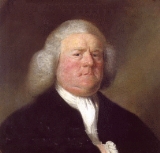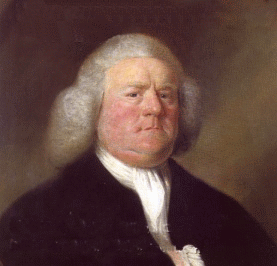
William Boyce
Encyclopedia

England
England is a country that is part of the United Kingdom. It shares land borders with Scotland to the north and Wales to the west; the Irish Sea is to the north west, the Celtic Sea to the south west, with the North Sea to the east and the English Channel to the south separating it from continental...
-born composer
Composer
A composer is a person who creates music, either by musical notation or oral tradition, for interpretation and performance, or through direct manipulation of sonic material through electronic media...
s of the 18th century.
Born in London
London
London is the capital city of :England and the :United Kingdom, the largest metropolitan area in the United Kingdom, and the largest urban zone in the European Union by most measures. Located on the River Thames, London has been a major settlement for two millennia, its history going back to its...
, Boyce was a choirboy
Choirboy
A choirboy is a boy member of a choir, also known as a treble.As a derisive slang term, it refers to a do-gooder or someone who is morally upright, in the same sense that "Boy Scout" refers to someone who is considered honorable or conscientious.- History :The use of choirboys in Christian...
at St Paul's Cathedral
St Paul's Cathedral
St Paul's Cathedral, London, is a Church of England cathedral and seat of the Bishop of London. Its dedication to Paul the Apostle dates back to the original church on this site, founded in AD 604. St Paul's sits at the top of Ludgate Hill, the highest point in the City of London, and is the mother...
before studying music with Maurice Greene
Maurice Greene (composer)
Maurice Greene was an English composer and organist.- Biography :Born in London, the son of a clergyman, Greene became a choirboy at St Paul's Cathedral under Jeremiah Clarke and Charles King...
after his voice broke. A house in the present choir school is named after him. His first professional appointment came in 1734 when he was employed as an organist at the Oxford Chapel
Marybone Chapel
The Marybone Chapel or Marylebone Chapel also known until 1832 as the Oxford Chapel after its founder Edward Harley, 2nd Earl of Oxford and Earl Mortimer, and now known as St Peter's Vere Street, was a former Anglican church off Oxford Street, London. It was designed by James Gibbs in 1722...
. He went on to take a number of similar posts before being appointed Master of the King's Musick in 1755 and becoming one of the organists at the Chapel Royal
Chapel Royal
A Chapel Royal is a body of priests and singers who serve the spiritual needs of their sovereign wherever they are called upon to do so.-Austria:...
in 1758. One of his students was the prodigy Thomas Linley
Thomas Linley the younger
Thomas Linley the younger was the eldest son of the composer Thomas Linley the elder and his wife Mary Johnson. He was one of the most precocious composers and performers that have been known in England, and became known as the "English Mozart".-Early life:Linley's abilities were apparent from a...
.
When Boyce's deafness became so bad that he was unable to continue in his organist posts, he retired and worked on completing the compilation Cathedral Music that his teacher Greene had left incomplete at his death. This led to Boyce editing works by the likes of William Byrd
William Byrd
William Byrd was an English composer of the Renaissance. He wrote in many of the forms current in England at the time, including various types of sacred and secular polyphony, keyboard and consort music.-Provenance:Knowledge of Byrd's biography expanded in the late 20th century, thanks largely...
and Henry Purcell
Henry Purcell
Henry Purcell – 21 November 1695), was an English organist and Baroque composer of secular and sacred music. Although Purcell incorporated Italian and French stylistic elements into his compositions, his legacy was a uniquely English form of Baroque music...
. Many of the pieces in the collection are still used in Anglican services today.
Boyce is best known for his set of eight symphonies, his anthem
Anthem
The term anthem means either a specific form of Anglican church music , or more generally, a song of celebration, usually acting as a symbol for a distinct group of people, as in the term "national anthem" or "sports anthem".-Etymology:The word is derived from the Greek via Old English , a word...
s and his ode
Ode
Ode is a type of lyrical verse. A classic ode is structured in three major parts: the strophe, the antistrophe, and the epode. Different forms such as the homostrophic ode and the irregular ode also exist...
s. He also wrote the masque
Masque
The masque was a form of festive courtly entertainment which flourished in 16th and early 17th century Europe, though it was developed earlier in Italy, in forms including the intermedio...
Peleus and Thetis and songs for John Dryden
John Dryden
John Dryden was an influential English poet, literary critic, translator, and playwright who dominated the literary life of Restoration England to such a point that the period came to be known in literary circles as the Age of Dryden.Walter Scott called him "Glorious John." He was made Poet...
's Secular Masque, incidental music
Incidental music
Incidental music is music in a play, television program, radio program, video game, film or some other form not primarily musical. The term is less frequently applied to film music, with such music being referred to instead as the "film score" or "soundtrack"....
for William Shakespeare
William Shakespeare
William Shakespeare was an English poet and playwright, widely regarded as the greatest writer in the English language and the world's pre-eminent dramatist. He is often called England's national poet and the "Bard of Avon"...
's The Tempest, Cymbeline
Cymbeline
Cymbeline , also known as Cymbeline, King of Britain or The Tragedy of Cymbeline, is a play by William Shakespeare, based on legends concerning the early Celtic British King Cunobelinus. Although listed as a tragedy in the First Folio, modern critics often classify Cymbeline as a romance...
, Romeo and Juliet
Romeo and Juliet
Romeo and Juliet is a tragedy written early in the career of playwright William Shakespeare about two young star-crossed lovers whose deaths ultimately unite their feuding families. It was among Shakespeare's most popular archetypal stories of young, teenage lovers.Romeo and Juliet belongs to a...
and The Winter's Tale
The Winter's Tale
The Winter's Tale is a play by William Shakespeare, originally published in the First Folio of 1623. Although it was grouped among the comedies, some modern editors have relabelled the play as one of Shakespeare's late romances. Some critics, among them W. W...
, and a quantity of chamber music
Chamber music
Chamber music is a form of classical music, written for a small group of instruments which traditionally could be accommodated in a palace chamber. Most broadly, it includes any art music that is performed by a small number of performers with one performer to a part...
including a set of twelve trio sonata
Trio sonata
The trio sonata is a musical form that was popular in the 17th and early 18th centuries.A trio sonata is written for two solo melodic instruments and basso continuo, making three parts in all, hence the name trio sonata...
s. He also composed the British and Canadian Naval March "Heart of Oak
Heart of Oak
"Heart of Oak" is the official march of the Royal Navy of the United Kingdom. It is also the official march of several Commonwealth navies including the Royal Canadian Navy, the Royal Australian Navy and the Royal New Zealand Navy....
". The lyrics were later written by David Garrick
David Garrick
David Garrick was an English actor, playwright, theatre manager and producer who influenced nearly all aspects of theatrical practice throughout the 18th century and was a pupil and friend of Dr Samuel Johnson...
for his 1759 play Harlequin's Invasion.
Boyce was largely forgotten after his death and he remains a little-performed composer today, although a number of his pieces were rediscovered in the 1930s and Constant Lambert
Constant Lambert
Leonard Constant Lambert was a British composer and conductor.-Early life:Lambert, the son of Russian-born Australian painter George Lambert, was educated at Christ's Hospital and the Royal College of Music...
edited and sometimes conducted
Conducting
Conducting is the art of directing a musical performance by way of visible gestures. The primary duties of the conductor are to unify performers, set the tempo, execute clear preparations and beats, and to listen critically and shape the sound of the ensemble...
his works. Lambert had already launched the early stages of the modern Boyce revival in 1928, when he published the first modern edition of the Eight Symphonys (Bartlett and Bruce 2001). The great exception to this neglect was his church music, which was edited after his death by Philip Hayes and published in two large volumes, Fifteen Anthems by Dr Boyce in 1780 and A Collection of Anthems and a Short Service in 1790 (Bartlett 2003, 54).
Boyce's portraits were painted by Joshua Reynolds
Joshua Reynolds
Sir Joshua Reynolds RA FRS FRSA was an influential 18th-century English painter, specialising in portraits and promoting the "Grand Style" in painting which depended on idealization of the imperfect. He was one of the founders and first President of the Royal Academy...
and Thomas Hudson
Thomas Hudson (painter)
Thomas Hudson was an English portrait painter in the 18th century. He was born in 1701 in the West Country of the United Kingdom. His exact birthplace is unknown...
. He was drawn and engraved by John Keyse Sherwin
John Keyse Sherwin
John Keyse Sherwin was an English engraver and history-painter.-Biography:Sherwin was born at East Dean in Sussex...
, and a vignette made by Drayton after Robert Smirke
Robert Smirke (painter)
Robert Smirke , was an English painter and illustrator.-Life and work:Smirke was born at Wigton near Carlisle, the son of a clever but eccentric travelling artist. In his thirteenth year he was apprenticed in London with an heraldic painter, and, at the age of twenty, began to study at the schools...
.
His only son, William Boyce, Jr (25 Mar 1764–1824), was a professional double bass
Double bass
The double bass, also called the string bass, upright bass, standup bass or contrabass, is the largest and lowest-pitched bowed string instrument in the modern symphony orchestra, with strings usually tuned to E1, A1, D2 and G2...
player.
External links
- William Boyce - biography
- William Boyce's "Solomon" (Oxford Journals - Music and Letters)
- Portraits of Boyce (National Portrait Gallery, London)

